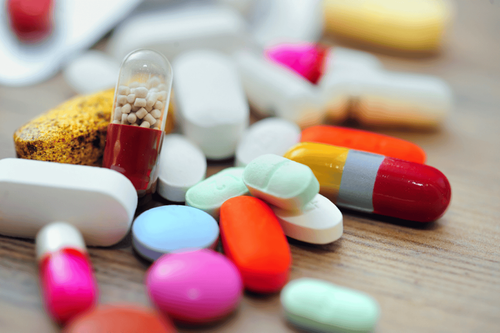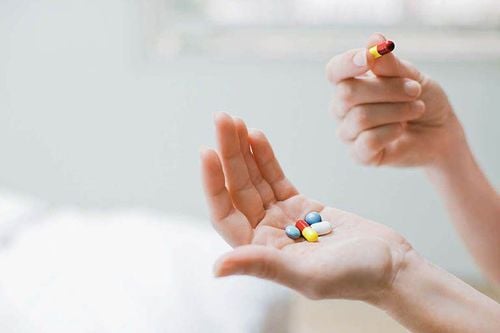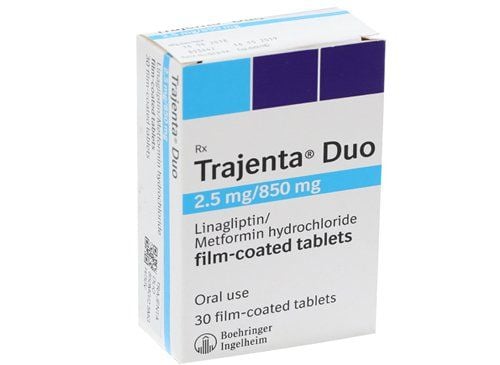This is an automatically translated article.
Meyersiliptin 50 is made in the form of tablets, with the main ingredient being Sitagliptin phosphate. The drug is used in monotherapy or in combination with other drugs for good blood sugar control in patients with type 2 diabetes.
1. Uses of Meyersiliptin 50
What is Meyersiliptin 50? The drug has the main ingredient is Sitagliptin phosphate 64.2mg equivalent to Sitagliptin 50mg. Meyersiliptin 50 belongs to the class of DPP-4 antihyperglycemic drugs, which improve blood sugar in patients with type 2 diabetes by increasing levels of the active hormone incretin. Incretin hormones, including GLP-1 and GIP, are released from the gut, increasing concentrations in response to meals. These hormone incretins are components of the endogenous system, participating in the physiological regulation of glucose homeostasis.
Indications for use of Meyersiliptin 50 :
Use as an adjunct to diet and exercise to improve glycemic control in patients with type 2 diabetes ; Use as monotherapy or in combination with other drugs (hyperglycaemic sulphonamides, metformin, PPARy agonists) to improve glycemic control in patients with type 2 diabetes. Meyersiliptin 50 indications:
People Hypersensitivity to Sitagliptin or any other ingredient of the drug.
2. How to use and dose Meyersiliptin 50
Usage: Orally. The patient can take it with or without food.
Dosage:
Usual dose: 100mg/time/day when used as monotherapy or in combination with the above drugs. When Meyersiliptin 50 is used in combination with a hypoglycaemic sulphonamide, a lower dose of a hypoglycaemic sulphonamide may be used to reduce the risk of excessive hypoglycaemia; Patients with hepatic impairment: Patients with mild to moderate hepatic impairment do not require dose adjustment. In patients with severe hepatic impairment, the safety and efficacy of the drug have not been established; Patients with renal impairment: For patients with mild renal impairment (Clcr above 50ml/min) no dose adjustment is required. For patients with moderate renal impairment (Clcr 30 - 50ml/min) the dose should be 50mg/time/day. For patients with severe renal impairment (Clcr less than 30ml/min) or end-stage renal disease requiring peritoneal dialysis, the dose is 25mg/time/day. Sitagliptin can be used at any time, regardless of the time of hemodialysis; Elderly: No dosage adjustment is necessary, but care should be taken when choosing a dose because the patient's renal function may be reduced; Children: Safety and effectiveness have not been established in children under 18 years of age. *Note: Because Meyersiliptin 50 requires dose adjustment based on renal function, patients should have their renal function assessed before starting treatment, and then periodically check.
Overdose: There is no experience with doses of Sitagliptin higher than 800 mg in humans. In the event of overdose, the usual supportive measures such as removal of unabsorbed drug from the gastrointestinal tract, clinical monitoring and supportive therapy should be applied. Sitagliptin can be dialyzed.
Missed dose: If you forget to take a dose of Meyersiliptin 50, the patient should take it as soon as possible. If it is almost time for your next dose, skip the missed dose and take your next dose at the scheduled time (do not take a double dose).
3. Meyersiliptin 50 . side effects
Some side effects patients may encounter when using Meyersiliptin 50 include:
Common: Hypoglycemia, headache; Uncommon: Dizziness, constipation, itchy skin; Frequency unknown: Anaphylaxis, interstitial lung disease, vomiting, pancreatitis, angioedema, rash, urticaria, Stevens-Johnson syndrome, exfoliative dermatitis, myalgia, back pain, arthralgia, arthralgia, failure decreased renal function or acute renal failure,... When using Meyersiliptin 50, if experiencing side effects, the patient should immediately notify the doctor for early intervention.
4. Be careful when using Meyersiliptin 50
Some notes patients need to remember before and while using Meyersiliptin 50:
Sitagliptin (the main ingredient of Meyersiliptin 50) should not be used in people with type 1 diabetes or to treat diabetic ketoacidosis - acid; Patients using Sitagliptin in combination with metformin are at increased risk of acute pancreatitis. When administering the drug to patients with a history of pancreatitis, caution should be exercised and close monitoring is required. Manifestations of pancreatitis such as nausea, vomiting, loss of appetite and persistent severe abdominal pain should be monitored. If pancreatitis is suspected, sitagliptin should be discontinued. The risk of pancreatitis usually occurs within the first 30 days of drug therapy; Sitagliptin is eliminated by the kidneys. To achieve plasma concentrations of sitagliptin similar to those in subjects with normal renal function, dose reduction is required in patients with moderate and severe renal impairment, end stage renal disease requiring hemodialysis or peritoneal dialysis. ; During times of stress (surgery, fever, infection) blood glucose control can be lost. Sitagliptin should be temporarily discontinued and insulin used to control blood glucose. Resuming sitagliptin therapy after the acute hyperglycemia has passed; During the first 3 months after starting treatment with Sitagliptin, patients may experience hypersensitivity reactions such as anaphylaxis, angioedema, exfoliative dermatitis, Stevens-Johnson syndrome,... If a reaction is suspected. hypersensitivity, sitagliptin should be discontinued, another cause evaluated, and other antidiabetic measures initiated; In clinical studies, the safety and efficacy of sitagliptin in the elderly (over 65 years of age) was similar to that in younger patients (under 65 years of age). Therefore, there is no need to adjust the dose of Sitagliptin according to age. Patients who are more likely to have renal impairment may require an adjustment in the dose of the drug if there is significant renal impairment; Avoid using Meyersiliptin 50 during pregnancy; Meyersiliptin 50 should not be used by women who are breastfeeding, unless authorized by a doctor after carefully weighing the benefits and risks; Meyersiliptin 50 may cause drowsiness, dizziness in a few patients, so be careful with drivers, operating machinery. Medications can be taken at bedtime to reduce side effects during the day.
5. Meyersiliptin 50 . drug interactions
Some drug interactions of Meyersiliptin 50 include:
Sitagliptin (the main ingredient of the drug Meyersiliptin 50) slightly increases the concentration of digoxin in the blood plasma. After co-administration of 0.25mg digoxin with 100mg sitagliptin daily for 10 days, digoxin AUG increased by 11% and Cmax by 18%. No dose adjustment of digoxin is required. However, in patients at risk of digoxin toxicity, it is necessary to monitor their health when using sitagliptin and digoxin simultaneously; Sitagliptin has mild interactions with substrates such as: CYP2C8, CYP2C9, CYP3A4, and organic cation transporters (OCTs). When using Meyersiliptin 50, patients should strictly follow the doctor's instructions. This ensures a better therapeutic effect of the drug and reduces the risk of unpredictable side effects.
Follow Vinmec International General Hospital website to get more health, nutrition and beauty information to protect the health of yourself and your loved ones in your family.
Please dial HOTLINE for more information or register for an appointment HERE. Download MyVinmec app to make appointments faster and to manage your bookings easily.













